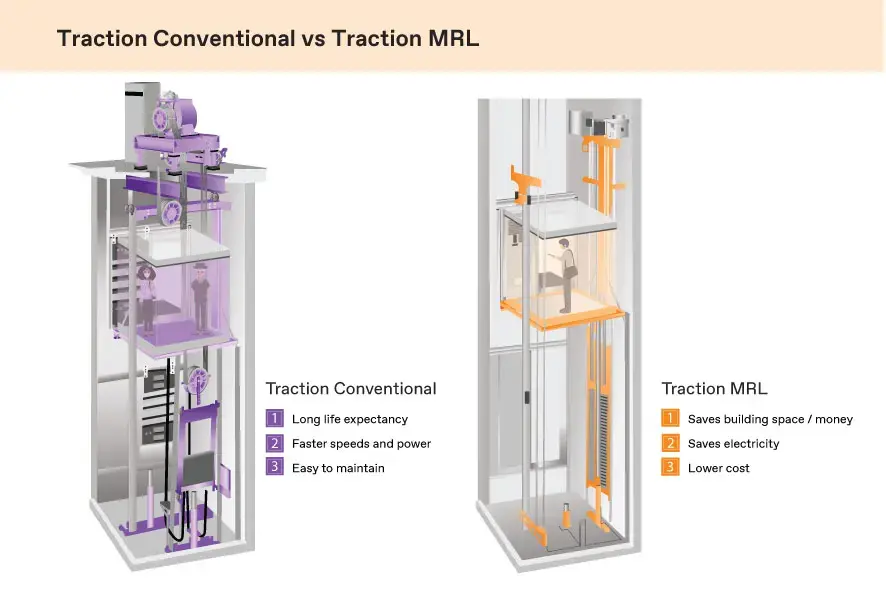Traction Conventional vs. Traction MRL
Sir Francis Bacon, the inventor of the modern scientific method, once said, “knowledge itself is power.” Since the holiday season is upon us, we thought it’d be best to give you a special gift in the form of elevator knowledge.
That’s right — it’s time to put on the fire, make yourself some steaming cocoa and get cozy to learn about the differences between a conventional traction elevator and a machine room-less (MRL) traction elevator.
Before we begin, we should first take the time to fully understand what a traction elevator is.
Since the early 1900s, traction elevators have been the worldwide standard for vertical transportation. Even with all the technology and great minds that have sprung up since, it remains one of two methods by which an elevator function — the other being hydraulic.
A traction elevator operates through a system of pulleys. The elevator cab is raised and lowered by belts or steel ropes with a counterweight to balance it. There is also a motor at the top which works seamlessly with the counterweight to help the cab travel up and down at fantastic speeds. For a full deep-dive explanation of traction elevators and the history of how they came to be, you might want to check out traction elevators on TKE’s Classroom On-Demand.
Traction elevators are a classic, timeless option that caters to a large variety of building heights and are a common go-to staple for building owners and managers. The question is: which is better? Traction with a machine room or without?
A Look at Machine Rooms
Now that we have a good grasp on what a traction elevator is and how it functions, it’s crucial that we understand the importance of a machine room or MRL technology.
Just like we all learned in middle school that the mitochondria is the powerhouse of the cell, the machine room or MRL technology is the powerhouse of the elevator. Machine rooms are areas built specifically to house the large machines which power an elevator. They contain important equipment like the controller and drives to ensure that the elevator cabs are running seamlessly throughout the day.
So, how can an elevator function without them?
Relatively new technology that arrived and was put to use in the 90s has seen the emergence of machine room-less elevators: a space-saving elevator with the machines and governors fitted compactly into the hoistway in which an elevator car travels.
There can be many advantages to the newer traction MRL technology and other advantages to sticking with the traditional traction elevator with a machine room. Let’s take at their respective pros to give you a good idea of which is better for your building.

Traction Conventional Pros
Machine room technology has been around since the reveal of the first passenger elevator back at the World’s Fair over 160 years ago. The technology is trusted, reliable and code compliant. Traction elevators with machine rooms also boast a slightly longer life expectancy.
If you have a tall building that requires faster speeds and more power for the number of passengers that it carries daily, the conventional traction elevator may be for you. Machine room traction elevators like momentum by TK Elevator are specifically designed with height and strength in mind.
Traction MRL Pros
For most other buildings, like residential or office spaces, machine room-less traction is the way to go. These buildings will want to save money by renting out leasable space and using it to their advantage, and machine rooms happen to take up quite a bit of that. The cost savings alone are a great reason for building managers to seek out a machine room-less traction elevator, but to add to the benefits — it’s also fantastic for saving energy.
Machine room-less technology is helpful for using up less energy than a sizable machine room would. Plus, there’s always technology on certain elevators like the evolution 100 and 200 by TK Elevator which offer a regenerative drive that feeds unused power back into your building’s power grid.
Tough Decisions
Whether you stopped by this article for more knowledge like Sir Francis Bacon, you wanted to learn what technology was best for you, or you’re looking to gift an elevator as a holiday present — I think we can all agree that both options are safe, trustworthy and secure.
The best thing about choosing which is right for you is that you can’t make a bad decision. Both technologies have many advantages and will keep your passengers on a smooth ride that will carry them to their intended destination.
Want to learn more about elevators? Read about the advantages of machine room vs. machine room-less hydraulic elevators.
 United States
United States

